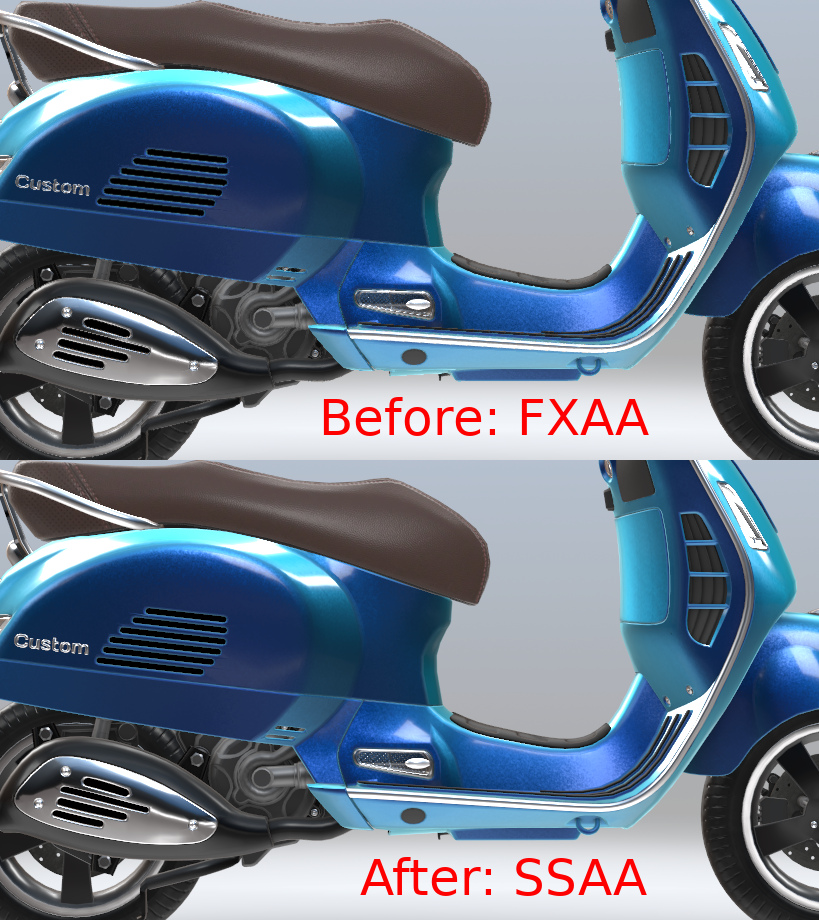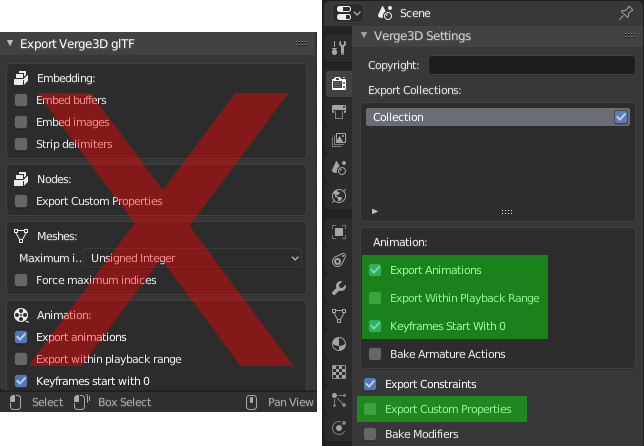Home › Forums › Official Announcements › Verge3D 2.12 pre3 available!
Tagged: pre-release
- This topic has 12 replies, 8 voices, and was last updated 6 years ago by
 elk.
elk.
-
AuthorPosts
-
2019-04-18 at 3:30 pm #14055
 Yuri KovelenovStaff2019-04-18 at 3:31 pm #14056
Yuri KovelenovStaff2019-04-18 at 3:31 pm #14056 Yuri KovelenovStaff
Yuri KovelenovStaffSSAA improvements
The new supersampling puzzle now works in HDR mode. We also fixed memory leaks produced by the SSAA puzzle.
The Scooter demo was upgraded to use the supersampling feature.

WebGL 2.0
WebGL 2.0 is now enabled by default on supported hardware thus unlocking various advanced features from this standard (see below).
Non-power-of-two (NPOT) are now directly supported without rescaling thus improving their quality.
HDR rendering is available for a wider range of devices (those that offer WebGL 2.0 support but do not expose the half-float texture WebGL extension).
Multisample anti-aliasing (MSAA) is now enabled for post-processing frame buffers which improves rendering quality for scenes with post-effects or outlining enabled.

Blender UI cleanup
Modified export interface in Blender UI:
– dropped all export panels in the export dialog
– moved options such as Export Animations, Export within playback range, Keyframes start with 0 and Export Custom Properties to the Render->Verge3D Settings panel.
3ds Max materials
We supported transparency settings for the physical material map. Namely, Weight, Color, Roughness (including the lock and the inverted option), and Thin-walled are now all supported. We also supported the Reflections -> IOR setting which can be used to create refractive materials.

Example apps
We removed some outdated/low-end demos from the Blender distribution. The demos will be reworked and added back in the future.
Bug fixes
- Fixed the open web page and open file puzzles crashing when the camera is set to No controls.
- Fixed the when moved puzzle not working properly with lists of objects.
- Fixed modifiers and normals not exported from recent Blender 2.8 builds.
- Fixed the bug with animations not working properly if their names contain the colon and forward slash symbols.
- Fixed the bug that prevented processing of high-resolution lines in Chrome.
- Fixed memory leaks when updating the scene’s environment map with Puzzles or JavaScript.
2019-04-18 at 5:07 pm #14057 AndrejusParticipant
AndrejusParticipant 2019-04-18 at 5:24 pm #14058
2019-04-18 at 5:24 pm #14058PD
Customer 2019-04-18 at 5:37 pm #14059
2019-04-18 at 5:37 pm #14059 roybellCustomer
roybellCustomer 2019-04-18 at 7:29 pm #14061
2019-04-18 at 7:29 pm #14061 elkCustomer
elkCustomer 2019-04-19 at 12:52 am #14068
2019-04-19 at 12:52 am #14068daveli
Participant 2019-04-19 at 3:39 am #140692019-04-19 at 6:09 am #14070
2019-04-19 at 3:39 am #140692019-04-19 at 6:09 am #14070 Mikhail LuzyaninStaff
Mikhail LuzyaninStaff
Co-founder and lead graphics specialist at Soft8Soft.
2019-04-19 at 6:44 am #14071 Yuri KovelenovStaff2019-04-19 at 11:02 pm #14097
Yuri KovelenovStaff2019-04-19 at 11:02 pm #14097 elkCustomer
elkCustomerFigured I could just add this here, since it is a little related to updates, and to give a bit more of a feedback then just
 ;
;Is there any plans to support some sort of “include” functionality where we could have “run” and “external calls” in separate files. This would make the updating a little easier, if say the code would look for a javascript file named custome-run.js, and add it at a predetermined place in the run function on the main script(on puzzles save for instance). The bigger advantage would probably be to make it much easier to make custome “libraries” for the same kinds of project. I could have my “master” script in one place, or several “master” scripts for different kinds of projects, and simply copy the file over older projects to update it with the new functionality I make later.
Also I am assuming that WebGL 2.0 will fallback gracefully to 1.0 !? But is there any performance benefits for whatever is WebGL 1.0 “compatible” or is the differens mostly the added/improved features?
EDIT: one more thing
 I just tested the default app scene in chrome and ie 11 to se the difference in 1.0 and 2.0, and the MSAA realy looks nice compared to the FXAA, so if I add SSAA will that then be used in both WebGL “versions” ? I am asuming the SSAA is more expencive so I would rely like to not use it for WebGL2 in most cases, as MSAA seems more than capable. Maybe an option in the init tab or something to chose WebGL version, atlest to be able to test the differances in one single browser. And maybe also get a method for testing what version is running. I know I can check for avalability in the “features” puzzle, but checking what is actualy run would be useful if we could make the choise of whitch to use in sertain cases… There also seemes to be a differance in the background if you set it to something other than 1 in 1.0 and 2.0, atlest in the chrome vs. IE (see attached)2019-04-20 at 10:22 am #14105
I just tested the default app scene in chrome and ie 11 to se the difference in 1.0 and 2.0, and the MSAA realy looks nice compared to the FXAA, so if I add SSAA will that then be used in both WebGL “versions” ? I am asuming the SSAA is more expencive so I would rely like to not use it for WebGL2 in most cases, as MSAA seems more than capable. Maybe an option in the init tab or something to chose WebGL version, atlest to be able to test the differances in one single browser. And maybe also get a method for testing what version is running. I know I can check for avalability in the “features” puzzle, but checking what is actualy run would be useful if we could make the choise of whitch to use in sertain cases… There also seemes to be a differance in the background if you set it to something other than 1 in 1.0 and 2.0, atlest in the chrome vs. IE (see attached)2019-04-20 at 10:22 am #14105 Yuri KovelenovStaff
Yuri KovelenovStaffgreat idea about external JavaScript files! This would simplify updating apps to new Verge3D versions too. Will think about this.

WebGL 2.0 will fallback gracefully to 1.0
Yep, if hardware is not compatible with WebGL 2.0 (corresponds to OpenGL ES 3.0) then the engine will run WebgL 1.0. Being a more advanced graphics API, WebGL 2.0 offers various quality and performance improvements over its predecessor.
the MSAA realy looks nice compared to the FXAA, so if I add SSAA will that then be used in both WebGL “versions” ? I
MSAA mostly works with geometry, while SSAA can also handle specular/reflection artifacts as well. SSAA, however, is much more computationally expensive than MSAA.
Maybe an option in the init tab or something to chose WebGL version, atlest to be able to test the differances in one single browser.
To run Chrome with no WebGL 2.0, you can use the command:
google-chrome --disable-webgl2
and check if WebGL 2.0 is actually disabled by navigating to this page
https://www.soft8soft.com/webglreportThere also seemes to be a differance in the background if you set it to something other than 1 in 1.0 and 2.0, atlest in the chrome vs. IE (see attached)
Thanks, we’ll check this! :)
2019-04-20 at 12:11 pm #14107 elkCustomer
elkCustomerI will do some more reading on the AA methods, but I get the basic differences now.
Thanks for the quick and good response as always.

-
AuthorPosts
- You must be logged in to reply to this topic.
